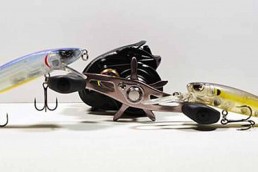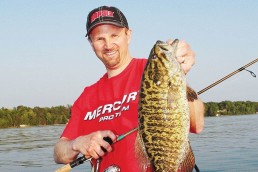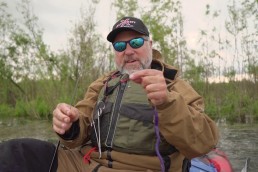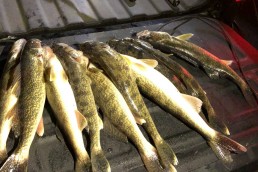Rip’em and Stick’em for Early-season Bass
SHARE THIS POST
Many of us will be hitting the water soon, and stickbaits will play a big part of how you will catch early-season bass. The water is at its coldest point of the season, driving the bass and its food to some of the deepest depths of the water system. When fishing a reservoir system, bass will have a tendency to head toward deeper-river channel areas—this will represent some of the deepest water in the area.
When inactive, bass will stay close to the bottom third of these creek channels. Food sources at this time of the season will hit these same corners as the bass, but will be located at different depths. Many times these food sources will hit the corners and suspend about half way down the corner break. For example, if the depth in the corner is 30 feet, the bass will be in that 20- to 25-foot range, but the bait will just drop off of the corner edge and be 12 to 18 feet.
Another situation you may come across is when the reservoir has standing timber located in its depths. Bass during this time of the season will take up residence in these trees. If the bass are inactive, you will find them scattered throughout the trees. One of the best ways to get them to bite when they are inactive is to target them with jigs or a jigging spoon.
When these bass become active they will make a move up into the tops of the trees and use the trees as cover, just waiting for the baitfish to move close to or over the tops of the trees. These bass will feed-up, using the tops of the trees as ambush points. When fishing in these conditions, one of the best lures you can use is a stickbait.
Electronics will also play a big part in helping you find bass. Set the SI range to 150 feet each side and start to run the creek channels, looking for signs of suspended baitfish. When you see the suspended bait on your screen, put a waypoint on these fish so you can get back on the school when you start to fish. If you do not have an SI unit, look for the turns of the creek channel that come close to shore on your map. These will be prime areas to find bait schooled. Run these areas with your electronics and look to see if you cannot locate suspended baitfish. Once you find the baitfish, the bass will not be far behind. Go over these areas to see if you can see the baitfish then mark a waypoint.
If you take these two different early-season feeding situations that I have laid out, you can plainly see that when the bass are feeding, they are often feeding in an “up” position and coming up to the bait to eat from below. This is why at this time of the season one of your first choices when choosing baits to target these fish should be a Spro stickbait. Spro makes a few different style stickbaits, the McRip and the McStick. Both of these baits have a distinct action and style. The McRip was made for the early season or when you need to get down a little deeper in the water column to reach bass located deep off the breaks. Follow that up with the McStick that will cover the shallower- to mid-depth areas and you have one of the best one-two stickbait combos ever made.
When it comes to equipment, I always start with a 6-foot, 6-inch or 7-foot, medium-action baitcaster rod teamed with a matching reel. Reel speed is critical: Some like the 5:3-1 version and some like the 6:3-1 version. Play with both speeds of reels and see what works best. The colder the water, the slower the reel I will use.
If you would ask Spro pro staff member and stickbait fishing master Mike McClelland what has changed the most in the last few years of stickbait fishing he will be the first to tell you: line choices. McClelland is a firm believer that mono is the best line to fish stickbait on. This is because mono line is neutrally buoyant.
Now throw in a few new lines from Sunline and you have some new thoughts on what line to use when stickbait fishing. Mike has also been using more of Sunline’s Reaction FC as a stickbait option. This is a new line that is a perfect match for working reaction baits. Reaction FC has a little more stretch than typical fluorocarbon line, making it a perfect line choice when looking for an option other than mono when throwing sticks—the less stretch factor of Reaction will allow you to work the stickbait with less physical stress on you. You will also see days when bass will want the bait hardly moving. These are the days to use mono. But when the bait has to be fished with a lot of action, you will want to fish your stickbait on Reaction FC.
Because of this, I usually have a few different rods set up with both reel speeds and the different lines lying on the boat deck to cover all my bases.
Are you enjoying this post?
You can be among the first to get the latest info on where to go, what to use and how to use it!
When it comes to early-season bass and stickbaits you have to make your bait selection play into the bass’ hand. That is one reason why stickbaits shine during this part of the season. With the warming water temps, bass will start to get more active and slowly start to go on the feed. Yes, you could throw crankbaits or spinnerbaits that will run above the bass, but the biggest key here is these baits will be in and out of the strike zone after a few turns of the reel handle. But with a stickbait you can zero in on these bass and get your offering to hold in that same strike zone for up to a few minutes.
If the bass are holding deeper in the water column, then it’s time to tie on a McRip. This bait will get down 8 to 10 feet on a long cast. If the bass are shallower, I will turn toward a McStick. The McStick will get down to the 3- to 8-foot range.
Once you have found bass on your electronics, grab either rod rigged with a McRip or McStick, and make a long cast with the setup you feel will get your bait down into the zone. Once the bait hits the water, reel the bait down with 8 or 10 turns of the reel handle and stop. This will get the bait down to the max depth that it can reach.
The McStick and McRip were designed to suspend in a slight nose-down position. This is a more of a natural look to the bass than a bait that sinks and sits in a tail-down position. To achieve this, Spro incorporates a weight transfer system in all of the McStick and McRip line of baits. The weights transfer to the back of the bait’s chamber when you make your cast, helping you get the casting distance you need. But when the bait hits the water and you start your retrieve, the weights transfer to the front of the chamber to get the bait into a slight nose-down position when you stop on a pause.
The inter-workings of the weight transfer system create the right “attitude” of the bait when it is paused and also gives the bait more of a slight “knocking” sound.
Remember, when fishing a stickbait, work the bait slowly. Keep your pauses on the long side to help you figure out how to get a reaction bite out of the bass. Start out pausing the bait 10 to 15 seconds between jerks. After the initial pause, allow the stickbait to settle into the correct position. When you want to move the bait, pull the bait forward with your rod tip, giving it a few slight jerks, picking up the line slack with the reel. Let the bait settle again, wait 10 to 15 seconds, then give the bait a few more slight jerks. As you are working the bait back to the boat, vary the pauses and the cadence of how you are fishing the bait. Make sure you pay attention to how you get bites though. This will help you put more bass in the boat.
A good rule of thumb when it comes to how long to pause your stickbait between cadences is, the colder the water, the longer your pause should be and the warmer the water, the faster you can work your stickbait. Experiment with different pause times and jerk patterns; when you find a pattern that works, work it all the way back to the boat.
Keep in touch with your bait and be aware of what happens when you stop your bait: Is it still sinking or does the bait slowly raise? If this is happening, you will need to make an adjustment to your bait. Adjustments can be made by adding a bigger hook to get the bait to keep from rising or go to smaller hooks if the bait is sinking out of the strike zone. It does not look natural to bass if the bait is rising on its pause. Another small adjustment you can do is to add another split ring to the middle hook. This slight adjustment may be all that is needed to keep the stickbait from rising on the pause.
When it comes to colors move toward Chrome Shad, Clown or Old Glory, that will create some flash when moving the bait if you are in stained water conditions. If the water you are fishing is clear, then pull out a Spooky Shad or Clear Chartreuse. If you are looking for a good general all-around color give Blue Bandit a try.
So, as you can see early season is stickbait time. Yes, you can try to put another bait on the bass that you see on your electronics, but can it hold in the strike zone like a stickbait can? That is one of the reasons these baits work so well in the early part of the season.
MWO
SHARE THIS POST
Did you enjoy this post?
You can be among the first to get the latest info on where to go, what to use and how to use it!
MWO
We believe being outdoors is good. With more than 1,000 articles each year, MidWest Outdoors magazine is all about sharing outdoor experiences with you—where to go, what to use and how to use it… whether you’re close to home or on that trip of a lifetime.



